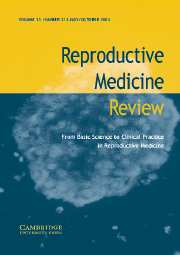Article contents
The role of interleukins in the ovary
Published online by Cambridge University Press: 03 June 2009
Extract
A brief look at the history of cytokine research shows that the term ‘lymphokine’ was first described in 1969 as the product of sensitized lymphocytes exposed to specific antigens. To eliminate the incorrect notion that such proteins can be produced only by lymphocytes, Cohen et al. (1974) proposed the term ‘cytokines’ to indicate their production also by nonlymphoid cells.2 After a long-persisting reluctance, it seems that ‘cytokine’ is becoming the prevalent term for these proteins. Meanwhile, a group of participants at the Second International Lymphokine Workshop held in 1979 proposed the term ‘interleukin’ in order to develop, ‘a system of nomenclature based on the protein's ability to act as communication signals between different populations of leukocytes’.3 They introduced the names IL-I and IL-2 for two important cytokines. Since then the number of described interleukins reached 16 and this number may increase. Furthermore, notwithstanding this previous notion, interleukins are now known to be produced in a variety of tissues other than leucocytes and affect the functions of many and diverse somatic cell types (e.g. IL-1 or IL-6). Therefore, while many cytokines are now termed as interleukins, others continue to be known by their old names [e.g. tumour necrosis factor-alpha (TNF-α)], suggesting that they had been recognized earlier, but all of them are included under the generic name of cytokines.
- Type
- Articles
- Information
- Copyright
- Copyright © Cambridge University Press 1996
References
- 6
- Cited by


